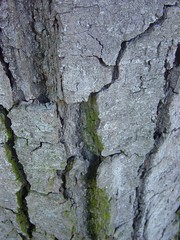
I recently discovered that there is not much on the Internet about tree bark. I think there should be more. See the Wikipedia article, which is roughly a page in length. There is a Flickr photo group, Bark Life, which has over 400 photos in it, but bark doesn't get the attention of leaves. The Flickr Leaf group has over 1700 photos. There are, of course, several groups on flowers, or even on particular kinds of flowers. Flowers, and, to a lesser extent, leaves, are showier than bark. But, let's not forget, they are transitory. Bark remains.
Why is bark interesting, or important? There are several reasons.
First, it is essential to the growth of woody plants. Bark protects the tree from disease. Bark contains phloem tissue, which brings the food produced in the leaves down to the rest of the plant. Where I grew up, rabbits sometimes girdled a tree in winter. That is, they ate all the bark in a ring around it, as high as they could reach. A girdled tree will die, because the phloem no longer brings food energy down to the roots.
Two very important medical products, quinine and aspirin, were originally derived from the bark of cinchona and willow trees, respectively. Quinine was the first effective treatment for malaria.
Bark is present when leaves and flowers aren't, hence is useful for identifying trees. One feature of bark is that it grows throughout the life of the tree. It has to, as the rest of the tree, mostly wood, is growing inside the bark. The fissures in many types of bark are because it is, as it were, stretching to accommodate this growth of the wood within. Some trees, like eucalyptus, don't fissure much, but slough off. Many types of tree bark does both.
Is bark, then, like the skin of humans? Well, yes, in some ways. We do use our skin to identify ourselves. Our skin does protect us. But there are differences. We use displays of skin, sometimes with the appearance altered by pigments, as a signal. There's no signaling of that kind between trees. The food-bearing functions of bark have no equivalent in humans.
Historically, bark played a significant role in science. Robert Hooke was looking at cells of cork, which is part of the bark of a tree, when he named them. He didn't have a full grasp of their significance, of course -- that is still coming to us -- but he started modern cell-based biology.
Cinnamon is derived from bark. Oak bark was the source of tannins used to process leather, in ancient times. Some mulch is made from bark, as is the surface of some playgrounds and walkways. Native Americans made quite a few items from birch tree bark. (see here for photo of some bark of an ornamental birch tree)
Bark is rather ordinary. But, ordinary things can be good. I like to think that Paul, in Romans 2:7, described ordinary things, and ordinary deeds:
to those who by patience in well-doing seek for glory and honor and immortality, he will give eternal life; (ESV)
I don't suppose Paul was thinking of bark when he wrote "patience in well-doing," but perhaps God was. I hope my life is bark-like, in that I protect, and nourish, and am where I am whenever I'm supposed to be, without being showy.
I'm sorry, but I don't know what kind of tree the one in the picture is.
Thanks for reading.


3 comments:
I never would've imagined bark could be so interesting! Thanks for the good read!
My husband is fascinated by sassafras bark, for some reason. We both like birch and river birch. Bark is great for starting a fire.
Thanks.
Bark has character, indeed, and it is good for starting fires.
Post a Comment